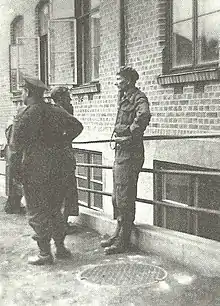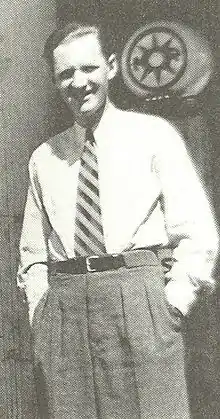Operation Claw
Operation Claw (Norwegian: Lillehammer-kuppet) was a joint Swedish–American operation, with Norwegian support,[1] that was carried out at Lillehammer shortly after the German capitulation by the end of World War II. Thirty-five German intelligence specialists were transferred along with various equipment first to Sweden and then to U.S. camps in occupied Germany through an agreement between the Americans and the German High Command of the Wehrmacht in Norway.

The intelligence material from Operation Claw, among it a Soviet codebook, became very useful for the Americans during the Cold War. Operation Claw was controversial both when it happened and afterwards. In 1945, it was controversial that the Americans operated in what was seen as a British controlled country, and that they secured information about its ally the Soviet Union, in cooperation with neutral Sweden. In later years, a hypothesis that the Norwegian resistance fighter Kai Holst's sudden death in June 1945 was related to his involvement in the Operation Claw has been put forward by among others the historian Tore Pryser.
Background
Even before the war in Europe ended the various allied states had begun the search for German scientists and other German expertise.[2] Signals intelligence had been vital during World War II and especially the British work with breaking the German codes, from the Enigma had been of huge importance.[3] The Yalta Conference in February 1945 had revealed conflicts of interest between the western allied nations on one side and the Soviet Union and the relation was severely strained.[4]
American intelligence organisations were very interested in German intelligence experts knowledge of the Soviet Union and immediately after the war in Europe ended they began to cooperate with the German Major General Reinhard Gehlen and his organisation Fremde Heere Ost (FHO) which had led German intelligence on the Eastern Front. It was part of an organized effort to obtain as much German intelligence information and personnel as possible; the operation had the name Target Intelligence Committee (TICOM).
The war was however still fought in East-Asia, the US and the Soviet Union were still allies and the Americans were counting on Soviet assistance in the war against Japan. The allies had designated Norway as part of the British sphere of influence.[5][6] Both for the US and the neutral Sweden the operation was thus very sensitive and was conducted in great secrecy.[7]
Swedish–American cooperation
In the Wehrmacht camp at Lillehammer a group of 35 German experts on signals intelligence were gathered. They had been working on the Eastern Front against Soviet forces and had an archive and extensive knowledge about Soviet affairs. This was knowledge the Western Allies, and especially the Americans, wanted and that probably also were of use during the Cold War.
In cooperation with the American intelligence organisation Office of Strategic Services (OSS) and with knowledge and support from the Norwegian legation[8] in Stockholm agents for the Swedish intelligence organisation C-byrån traveled together with two Norwegian intelligence specialists to Lillehammer on May 9 and 10, 1945.[1] The German group of experts were taken out of the camp and transported to Sweden.[9][10] After a few weeks in Sweden they were on June 12 flown from Torslanda Airport close to Gothenburg to US occupied Germany and were interned in an American military camp at Wiesbaden.[10]
The transfer to Sweden of the German experts at Lillehammer, that OSS called Operation Claw, was directed from the highest level. From the U.S. side the leader of OSS, Major General William J. Donovan was involved, from the Swedish side the chief of the Defense Staff, Major General Carl August Ehrensvärd.[10] The famous Swedish police director Harry Söderman was also involved from the Swedish side.[11]
British–Norwegian raid of June 1945
More than a month after the German capitulation, a British led search supported by Norwegian personnel [12] was executed in order to find people from Gestapo and other German key personnel that tried to hide among ordinary soldiers in German military camps.[9] The search force that Kai Holst and other Norwegians were assisting were soon aware of that a number of German key personnel had been removed in the Swedish–American operation a month earlier.[13]
Kai Holst had been working at the military office number 4 (Mi4) at the Norwegian legation in Stockholm,[14] and after the search he unexpectedly traveled right back to Stockholm. The next day he was found shot at the top of the staircase in an apartment building at Rindögatan 42 on Gärdet. The official cause of death was stated as suicide, but neither Holst's family nor many of his colleagues from the resistance movement have accepted this and are of the opinion that he was liquidated.[15] The historian Tore Pryser has put forward the hypothesis that Holst brought with him information from Lillehammer that could damage Operation Claw and thus was killed.[16] To be able to damage the operation Kai Holst can not have been trusted as others were. He must have been considered a threat due to his contact with Alexandra Kollontaj who was ambassador in Stockholm representing Soviet Union. A possible reason for a murder of Kai Holst was thus not his knowledge as such but his connections.
Aftermath
Operation Claw was the beginning of the postwar era cooperation between Swedish and US intelligence services, in violation of Sweden's officially stated neutrality.[17] From the American side the operation was viewed as a great success and the responsible within OSS, William T. Carlson and Joseph T. Kloman, were both honored with decorations where the operation specifically were mentioned.[18][19] For the Swedish C-byrån Operation Claw quickly became toxic. Even though the operation was to be kept confidential, information leaked to the Swedish press and C-byrån were dissolved in February 1946.[20]
Information regarding Operation Claw continued to be classified as confidential in the post-war years and some of it still remains so today. A report about the operation in the British National Archives is restricted until 2020.[21]
References
Footnotes
- "The day after the message of the German capitulation in Norway arrived, a Tuesday, Törneman arrived on request from Petersén around one PM. With Petersén was the Norwegian major Dahl, then chief of the Norwegian intelligence office in Stockholm. At the visit there were stated a wish for Törneman to travel to Lillehammer and there take contact with Sala and from him receive certain content. More was not said of that part, and to Stockholm transfer this content and also as much content as Törneman could get his hands on from the German staff at Lillehammer. Törneman were promised assistance from available Norwegian personnel and he selected a Lieutenant Sjetne and Hans Peter Eggen.", statement by Törneman in 1948, from the radio program Den mystiska kofferten från Lillehammer, from 21:05 in the recording
- Bower, Tom (1987). The paperclip conspiracy : the battle for the spoils and secrets of Nazi Germany. London: M. Joseph. ISBN 0-7181-2744-7.
- Miller, A. Ray (2001). "The Cryptographic Mathematics of Enigma" (PDF). National Security Agency.
{{cite journal}}: Cite journal requires|journal=(help) - Gaddis, John Lewis (1972). The United States and the origins of the Cold War, 1941-1947. New York: Columbia University Press. ISBN 0-231-08302-5.
- Zimke, Earl F. (1959). German northern theatre of operations, 1940-45. U S Govt Printing Office. ISBN 0-16-001996-6.
- "The so-called "Lillehammer-kuppet" (Norwegian name, translators remark) or Operation Claw as OSS called it, was executed behind the back of both the British and the Norwegians. British military authorities were in charge of the German capitulation in Norway. Thus Sala's men and archives were British war bounty. But the British was (sic) cheated by the Swedes which again cooperated with the americans.", Svik og gråsoner, 162
- "Donovan himself flew from Washington to London for a conference regarding the transfer. It happened in great secrecy. Especially the Swedish high command feared that the transfer would be discovered and would be a problem for Sweden's official policy of neutrality. In a memorandum dated June 7, 1945 from J. T. Kloman to brigadier Kessler, the US military attaché in Stockholm it is revealed that the transfer had to be fast In order to avoid all complications with the Norwegians and the Russians (Tore Prysers utheving).», Svik og gråsoner, 186
- "On the day of capitulation Algot Törneman, with Norwegian knowledge and with good contacts with the Norwegians, got the task of going to Lillehammer to collect Sallas' archive. The Norwegians in Stockholm had confirmed the operation.", from the radio program «Den mystiska kofferten från Lillehammer», from 20:46 in the recording
- Svik og gråsoner, 161
- Svik og gråsoner, 185–186
- Svik og gråsoner, 165
- "The razzia was initiated and led by the British major W. D. MacRoberts from Task Force with support from Norwegian intelligence personnel and the police.", from Svik og gråsoner, 169
- USAs hemmelige agenter, 151
- Fra varm til kald krig
- "Also a lot of other friends and colleagues of Holst from the war reject the suicide theory. They argue that the Swedish police showed little ability or will in solving the case", Fra varm til kald krig, 105
- Fra varm til kald krig, 127–129
- USAs hemmelige agenter, 147
- USAs hemmelige agenter, 148
- USAs hemmelige agenter, 167
- USAs hemmelige agenter, 152
- «Dyrhaug has also identified a document in the British National Archive with the title Post Use of a German Intelligence Unit by Sweden». But this is restricted for 75 years and is therefor not available until year 2020. Svik og gråsoner, 166
Sources
- Tore Pryser, Tyske hemmelige tjenester i Norden. Spionsaker og aktører, 1930–1950, Universitetsforlaget, Oslo, 2012 ISBN 9788215020594
- Tore Pryser, Fra varm til kald krig : etterretningskuppet på Lillehammer i frigjøringsdagene 1945 og et mulig mord. Oslo, Universitetsforlaget, 1994 ISBN 82-00-21942-9
- Tore Pryser, Svik og gråsoner: Norske spioner under 2. verdenskrig. Spartacus forlag, Oslo 2010 ISBN 9788243005075
- Tore Pryser, USAs hemmelige agenter : den amerikanske etterretningstjenesten OSS i Norden under andre verdenskrig, Oslo, Universitetsforlaget, 2010 ISBN 9788215015866
- Espen Haavardsholm, Taushetens pris, Oktober forlag, Oslo 1995 ISBN 8270947156
- Ole Kristian Grimnes m.fl. Motstandskamp, strategi og marinepolitikk, Oslo, Universitetsforlaget, 1972 ISBN 82-00-03172-1
